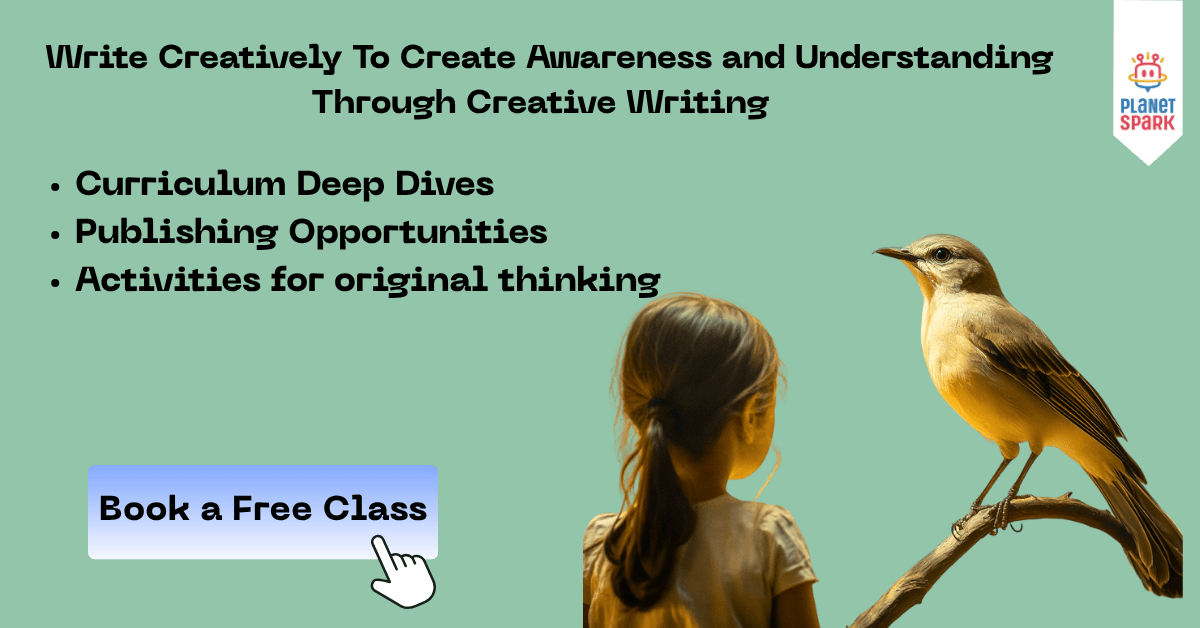In-Depth To Kill a Mockingbird Analysis & Themes

Harper Lee’s To Kill a Mockingbird is a masterclass in symbolic storytelling. Set in the racially charged American South during the 1930s, the novel follows Scout Finch as she recounts the events surrounding her father, Atticus Finch, and the trial of a Black man, Tom Robinson, wrongly accused of crimes against a white woman. Beneath its compelling narrative lies a rich tapestry of symbols that reflect the novel’s core themes: racial injustice, loss of innocence, and moral growth. These symbols not only deepen the narrative but also help readers connect emotionally and intellectually with the story.
In this blog, we will explore the most significant symbols in To Kill a Mockingbird, their thematic meanings, and how they contribute to the moral and psychological development of its characters. Along the way, we’ll also discuss how PlanetSpark’s Creative Writing Courses can help young writers identify and use symbolism in their writing.
The Mockingbird: A Symbol of Innocence and Moral Goodness
One of the most prominent symbols in Harper Lee’s To Kill a Mockingbird is the mockingbird itself. In the novel, mockingbirds represent innocence and harmlessness. The statement, “It’s a sin to kill a mockingbird,” delivered by Atticus Finch, signifies the importance of protecting those who do not harm others. Tom Robinson and Boo Radley are two prime characters who embody the mockingbird symbol. Both are innocent but suffer due to the ingrained prejudices of society.
Tom Robinson, a black man falsely accused of raping a white woman, is an unmistakable representation of a mockingbird. Despite clear evidence of his innocence, the racial bias of the jury led to his conviction. His fate reveals the deep-seated injustice that taints the legal and moral systems of the American South.
Boo Radley, the reclusive neighbor, is another symbolic mockingbird. Initially perceived as a frightening figure by the children, Boo ultimately proves to be compassionate and protective. He saves Scout and Jem from an attack and demonstrates that those misunderstood by society often possess great kindness.
Want to see your child express deeper themes through creative writing? Attend a free PlanetSpark trial class and discover their storytelling potential.
Tom Robinson:
A Black man falsely accused of raping Mayella Ewell, Tom represents the ultimate mockingbird. Despite his innocence, he becomes a victim of deep-seated racial prejudice. His tragic death is a powerful condemnation of societal injustice.
Boo Radley:
Initially perceived as a reclusive and possibly dangerous figure, Boo ultimately emerges as a gentle soul who saves Scout and Jem from harm. Like Tom, Boo does not harm others and only acts out of kindness. He, too, is a mockingbird, misunderstood and victimized by society’s fear and prejudice.
Theme Connection:
The mockingbird symbolizes innocence destroyed by evil. It encapsulates the novel’s central moral lesson: the importance of recognizing and protecting goodness in others.
Want your child to master literary devices like symbolism? Enroll them in PlanetSpark’s Creative Writing Courses and watch them flourish as thoughtful, expressive writers.
The Camellia Flowers: A Lesson in Forgiveness and Moral Courage
Mrs. Dubose’s camellia flowers, particularly the white camellia she leaves for Jem, represent moral courage and forgiveness. Jem destroys her flower bushes in a fit of rage after she insults Atticus. As punishment, he has to read to her every day, a punishment that becomes a lesson in resilience.
Symbolic Meaning:
The camellia is not just a gesture of peace; it’s a symbol of complexity in human morality. Mrs. Dubose was battling a morphine addiction and wanted to die free of it. Despite her harsh exterior and racist views, she possesses a certain moral bravery that Atticus respects and wants Jem to understand.
Theme Connection:
This symbol reflects the theme of moral complexity and redemption. People are not just good or evil, they are complex beings capable of change, courage, and contradiction.

Boo Radley’s Gifts in the Tree: An Emblem of Silent Friendship and Kindness
Boo Radley’s act of leaving gifts: gum, soap dolls, a broken watch, and more in the knothole of a tree is a symbol of silent communication and budding friendship. These gifts serve as Boo’s only way to connect with Scout and Jem.
Symbolic Meaning:
The items are small, but they carry immense emotional weight. Each object is carefully chosen, revealing Boo’s attention and care. They symbolize his desire to befriend the children and protect them from a distance.
Theme Connection:
This quiet act of kindness illustrates the theme of misunderstood humanity. Boo is wrongly judged by society but ultimately proves to be a compassionate, watchful figure. The tree becomes a metaphor for unspoken kindness and tentative trust.
The Rabid Dog: A Manifestation of Madness and Social Illness
When Atticus is called upon to shoot a rabid dog roaming the neighborhood, the scene appears at first to be a simple moment of action. However, the dog is symbolic of a deeper rot: racism, that plagues the town.
Symbolic Meaning:
The rabid dog represents uncontrollable madness: an infection that must be stopped before it spreads. Atticus, the moral compass of the novel, is forced to kill it, symbolizing his role in confronting societal evils.
Theme Connection:
This moment underscores the theme of moral responsibility. Sometimes, doing the right thing means confronting danger and evil head-on, even if it’s difficult or unpopular.
Through PlanetSpark’s writing workshops, students learn how to weave social commentary into storytelling, an essential skill for young change-makers.
Atticus’s Glasses: A Symbol of Insight and Vulnerability
In the scene where Atticus shoots the rabid dog, he removes his glasses, his symbol of clarity and control. This act momentarily strips him of his intellectual identity and forces him to rely on instinct.
Symbolic Meaning:
The glasses represent intellect, logic, and vision. Without them, Atticus becomes more human, vulnerable, and emotionally exposed.
Theme Connection:
The removal of the glasses reflects the duality of strength and vulnerability. Even the most morally upright individuals must act under uncertain and emotionally charged circumstances.
Scout’s Overalls and Dress: Gender Norms and Identity
Throughout the novel, Scout struggles with societal expectations about what it means to be a “proper” girl. Her preference for overalls over dresses becomes a symbol of resistance.
Symbolic Meaning:
Scout’s attire symbolizes freedom from traditional gender roles. It reflects her tomboy spirit and desire to engage in the same activities as her brother Jem.
Theme Connection:
The clothing becomes a metaphor for identity, independence, and challenging societal norms. Harper Lee uses this subtle symbol to critique gender expectations in the early 20th-century South.
Ready to help your child challenge norms and express their unique voice through storytelling? PlanetSpark’s Creative Writing Course is just a click away.
The Courthouse and the Oak Tree: Justice, Injustice, and Time
The Courthouse: The Maycomb courthouse is central to the novel’s climax and serves as a symbol of institutional justice and its failures.
Symbolic Meaning:
The courthouse’s physical prominence in the town belies the moral decay inside its walls. It becomes the setting for the miscarriage of justice against Tom Robinson, highlighting the deep racial biases of the legal system.
The Oak Tree:
The tree outside Boo Radley’s house is a site of connection. It is where the children find Boo’s gifts.
Symbolic Meaning:
The tree stands for hope, connection, and the natural instinct for human kindness. When it’s cemented shut by Nathan Radley, it symbolizes the forced end of communication and compassion.
Theme Connection:
These symbols reinforce the themes of justice, connection, and the loss of innocence. While the courthouse shows the failures of human institutions, the tree offers a glimpse of genuine human empathy.
The Radley House and Gothic Elements
The Radley house stands as a powerful symbol of fear, mystery, and prejudice. To Scout, Jem, and Dill, the Radley residence is a place of shadows and whispered stories. This setting reflects the gothic atmosphere that pervades much of the novel and symbolizes society’s fear of the unknown or misunderstood.
This fear is rooted not only in ignorance but also in the tendency of society to ostracize those who do not conform. Boo Radley’s character development, from a figure of terror to one of empathy, mirrors the children’s growing maturity and the novel’s central theme of looking beyond appearances.
Give your young storyteller the skills to craft meaningful narratives. Book a free trial class with PlanetSpark and start your writing journey today.
The Camellias and Mrs. Dubose
The white camellias that Mrs. Dubose gives to Jem after her death symbolize forgiveness, understanding, and personal bravery. Initially, Jem sees Mrs. Dubose as cruel and bitter. But Atticus reveals her struggle with morphine addiction and her determined effort to die free of it. The camellias stand as a token of her moral victory and a reminder that courage comes in many forms.
Atticus uses this moment to teach Jem that real courage is "when you know you're licked before you begin but you begin anyway and you see it through no matter what." The camellias thus become a lesson in compassion and the complexity of human character.
The Tree Knothole
The knothole in the tree near the Radley house acts as a secret communication channel between Boo Radley and the Finch children. Through the gifts Boo leaves, soap dolls, chewing gum, and a broken watch, the children slowly come to see Boo not as a figure of fear but of friendship.
The knothole represents the potential for human connection that exists even in the most isolated circumstances. When Nathan Radley cements the hole, it symbolizes society’s tendency to sever such connections out of fear, control, or misunderstanding. The act of sealing the knothole is symbolic of the silencing of Boo’s voice, just as Tom Robinson’s voice is silenced by the justice system.
The Mad Dog
The mad dog, Tim Johnson, is an overt symbol of the danger of racism. The dog’s illness represents the spread of irrational fear and hatred throughout Maycomb. Atticus, tasked with shooting the dog, symbolizes the voice of reason and justice attempting to eradicate this sickness.
Although Atticus is a moral hero, his efforts are not always enough to overcome the entrenched racism of his community. The mad dog scene is both literal and metaphorical, a turning point in the children’s understanding of their father and the evils that plague their society.
Societal Themes
Racism and Injustice
Racism forms the backbone of many of the conflicts in To Kill a Mockingbird. The trial of Tom Robinson shows how deeply racism is ingrained in the legal system and the hearts of the townspeople. Despite overwhelming evidence proving his innocence, Tom is convicted solely because of his race.
Atticus’s role as Tom’s defense lawyer places him in conflict with much of the town, and he becomes a beacon of justice and integrity in a corrupt society. The theme reveals the destructive power of racial prejudice and the difficulty of confronting systemic injustice.
Moral Growth and Coming of Age
Scout and Jem’s journey is central to the novel’s exploration of moral development. Through their interactions with Boo Radley, Tom Robinson, and their father, the children learn that good and evil coexist in people and situations are rarely black and white.
Scout’s growth is particularly notable as she begins the novel naive and idealistic and ends it with a deeper understanding of human nature and morality.
Courage and Integrity
Courage takes many forms in the novel. For Atticus, it is standing up for justice even when defeat is certain. For Mrs. Dubose, it is battling addiction. For Boo Radley, it is venturing out to protect the Finch children. Lee challenges traditional notions of bravery, showing that true courage often lies in personal sacrifice and quiet resilience.
Build your child’s confidence in writing and comprehension. Join PlanetSpark’s Creative Writing Course with a free introductory session.
Character Sketches
Atticus Finch
Atticus is the moral center of the novel. A principled lawyer and father, he believes in justice, compassion, and education. His decision to defend Tom Robinson sets him apart in a racially divided town and serves as a model of integrity for his children. His calm demeanor, intellectual approach, and unwavering moral compass make him a timeless figure of ethical leadership.
Scout Finch
Scout, the narrator, is an intelligent, spirited girl who evolves significantly throughout the novel. Her observations provide insight into the prejudices and hypocrisies of Maycomb. Scout’s transformation from innocence to awareness is central to the novel’s coming-of-age theme. Her perspective allows readers to explore societal issues with both honesty and curiosity.
Jem Finch
Jem, Scout’s older brother, undergoes profound emotional growth. He begins to grapple with injustice and morality after witnessing the trial. His idealism is challenged, and his journey reveals the pain of recognizing that fairness does not always prevail in the real world. Jem’s protective instincts and introspection reflect his maturing understanding of humanity.
Boo Radley
Arthur "Boo" Radley is a mysterious figure who ultimately emerges as a gentle and protective presence. Misjudged by society, Boo represents the dangers of rumor and isolation. His actions, leaving gifts, covering Scout with a blanket, and saving the children, reveal a deep empathy and highlight the novel’s message about not judging others without understanding their circumstances.
Tom Robinson
Tom is a symbol of innocence destroyed by evil. A kind, hardworking man, he becomes a scapegoat for a racist society. His wrongful conviction and tragic end underscore the destructive power of prejudice and the failure of the justice system.
Calpurnia
Calpurnia, the Finch family’s housekeeper, is a bridge between the white and Black communities of Maycomb. She is strict yet loving, and she plays a key role in Scout and Jem’s upbringing. Calpurnia’s presence adds depth to the exploration of race, class, and identity.
Dill Harris
Dill, a close friend of Scout and Jem, adds a sense of adventure and curiosity to the narrative. His perspective, shaped by a different upbringing, offers contrast and sparks many of the children’s discoveries. Dill’s emotional response to the injustice of Tom Robinson’s trial reflects the moral awakening that pervades the novel.

PlanetSpark’s Creative Writing Courses: Empowering Young Minds to Write with Purpose
Understanding and using symbols like the mockingbird or camellia requires not just creativity, but critical thought. At PlanetSpark, we offer:
- Live Interactive Classes: With expert educators who personalize lessons.
- Theme-Based Writing Modules: Focused on character development, symbolism, and plot layering.
- Peer Review and Instructor Feedback: To build critical thinking and editing skills.
- Project-Based Learning: Where students write full stories, scripts, and essays.
- Gamified Learning Tools: To keep engagement high and learning fun.
Our Creative Writing Course is more than just learning to write; it’s about learning to think, analyze, and express with confidence. Whether your child is a budding author or just starting, PlanetSpark equips them with the tools to craft stories that matter.
Interested in helping your child understand powerful literary tools like symbolism? Sign them up for a free trial session of PlanetSpark’s Creative Writing Course.
Conclusion
To Kill a Mockingbird remains timeless not just because of its compelling narrative but because of its masterful use of symbolism. Each symbol, from the mockingbird to the courthouse, adds layers of meaning, enriching our understanding of human nature and society. Recognizing these symbols enhances not only our appreciation of the novel but also our ability to think critically about the world.
FAQs
- What does the mockingbird symbolize in To Kill a Mockingbird?
The mockingbird symbolizes innocence and the injustice of harming innocent beings. Characters like Tom Robinson and Boo Radley represent this symbol.
2. Why are camellia flowers important in the novel?
Camellias symbolize forgiveness, resilience, and moral complexity, especially in the subplot involving Mrs. Dubose and Jem.
3. What is the meaning behind Boo Radley’s gifts?
The gifts symbolize kindness, communication, and Boo’s desire to befriend the Finch children despite societal rejection.
4. What does the rabid dog scene represent?
The rabid dog symbolizes uncontrollable social madness, like racism. Atticus’s role in stopping it underscores his moral responsibility.
5. Why does Atticus remove his glasses when shooting the dog?
Removing his glasses symbolizes vulnerability and a departure from logic-driven action to instinctual moral courage.
6. How does Scout’s clothing serve as a symbol?
Scout’s preference for overalls symbolizes her resistance to traditional gender roles and desire for autonomy.
7. What do the courthouse and the tree symbolize?
The courthouse symbolizes institutional failure and injustice, while the oak tree symbolizes connection, hope, and the fragility of empathy.
Personalized Communication Report
Record a video to get a AI generated personalized communication report for your child

Hi There, want to try these
tips for your child with
LIVE with our expert coach?
Let's check your child's
English fluency
